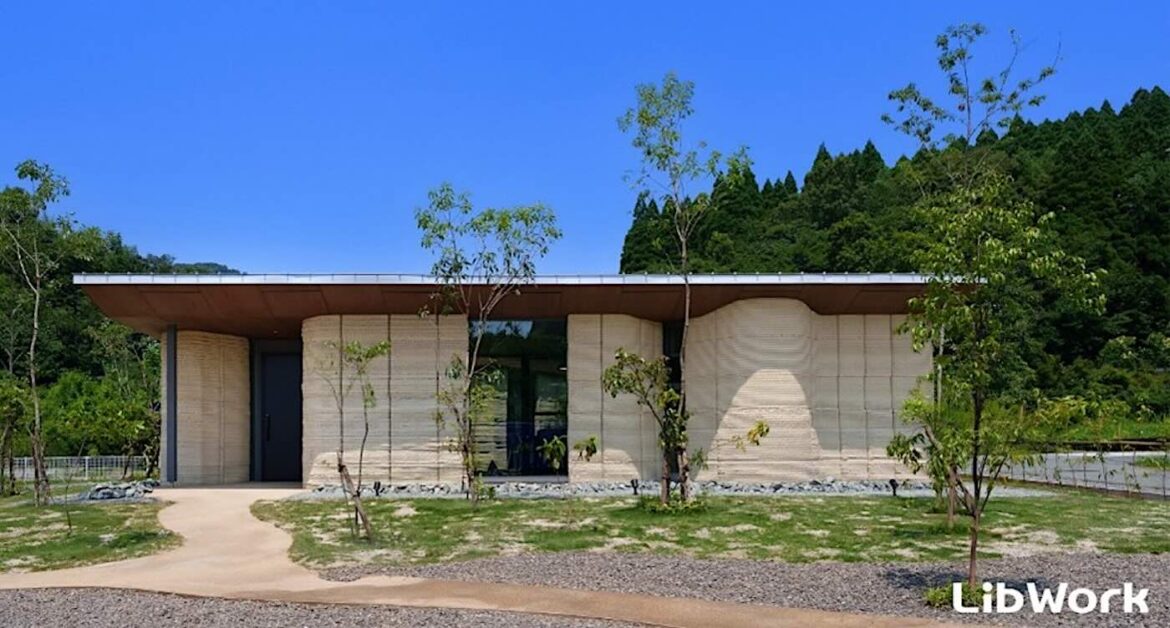 First 3D printed Earth House by Lib Work, Ltd
First 3D printed Earth House by Lib Work, Ltd
Collaborating with robotics engineers and Italian 3D printer manufacturers, a Japanese company is building “homes of earth” made primarily from soil.
Utilizing AI technology from design through construction, Lib Work, Ltd. completed their first 3D-printed earth home in Yamaga, Kumamoto on July 22, calling their creative process “uncharted territory where tradition and convention offered no guide”.
While the automotive industry has undergone rapid transformation through technological advances, the housing industry has seen virtually no fundamental innovation in construction methods, materials, or structures for over 50 years.
With an eye toward recycling, sustainability, and reduced carbon emissions, Lib Work focused on combining 3D-printing with natural materials enhanced for strength, constructibility, and design quality.
The walls of the completed Lib Earth House Model B use no cement (which produces industrial waste). Instead, they utilized only naturally derived materials with soil as the primary component to create sustainable earthen walls.
Compared to the previous model (Model A) that used some cement, the building’s strength has improved approximately fivefold while significantly reducing CO2 emissions from the manufacturing process itself.
The inventions from this development are patent pending, but pre-orders are being accepted this summer, according to their media release.
 3D printing walls – Lib Work via YouTube
3D printing walls – Lib Work via YouTube
The walls contain cutting-edge sensors as part of a wall condensation monitoring system that monitors in real-time the temperature and humidity inside the walls. This system enables the house to manage its own condition by detecting condensation in advance to maintain a long-lasting, comfortable living environment.
Additionally, the homes include remote operation of air conditioning, lighting, and bath controls via smartphone or dedicated monitor. It also features an off-grid energy system that combines Tesla’s Powerwall battery storage with solar panels to create an electrically independent, self-sufficient home.
 Lib Work
Lib Work
A courtyard incorporates natural light and ventilation.
“Together with Lib Work, we hope to continue to provide architectural solutions that contribute to achieving a recycling-centered society,” said 3D Printer collaborators Ove Arup and Partners.
“By using local soil for on-site material production, and by making all components easily removable, separable, and reusable/recyclable, we aim to provide reusable architecture that produces no waste when demolished.”
3D PRINTED HOMES OF WOOD: The World’s Largest 3D Printer Is Building Cozy Homes from Wood
The 3D printer manufacturer, Wasp, which provided the crane printer “heartily” congratulated the Lib Work team who paved the way for Japan to play a leading role in sustainable architecture.
“Their work fuses minimal design with organic inspiration, creating an aesthetic sensibility reminiscent of the Japanese ‘kintsugi’ philosophy that celebrates uniqueness and the beauty of natural materials.”
 Lib Work
Lib Work
LOOK: World’s Tallest 3D-Printed Structure Rises 4 Stories into the Air Like a Wedding Cake, Inspired by Local Bakeries
The AI development partner, Maket Technologies, said, “Our envisioned future is not about building the same houses faster but designing and optimizing the most suitable housing for each individual—accessible housing for everyone.
Through these cutting-edge initiatives, Lib Work’s goal is the construction of 10,000 units by 2040—but there was no information yet on their cost.
GREAT NEWS: First 3D Printed Neighborhood is Providing 100 Sturdy Affordable Solar Homes Near Austin For $400K+
BUILD SOME LIKES By Sharing This Cutting-Edge Home on Social Media…


AloJapan.com